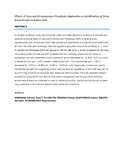Effects of Urea and Di-Ammonium Phosphate Application on Acidification of three Burundi representative Soils
Date
2019-08-06Author
KABONEKA, Salvator
ONG’OR, Basil T. Iro
Chantal, KWIZERA
Gaston, NSAVYIMANA
BUZOYA, Donatien
NTUKAMAZINA, Népomuscène
Metadata
Show full item recordAbstract
An 8-week incubation study was conducted under controlled laboratory conditions to evaluate the potential acidifying effect of urea and Di-Ammonium Phosphate (DAP) on three Burundi representative soils, namely two acidic high altitude soils (Nyabisindu and Kajondi) and a saline-sodic soil from the Imbo plain (Gihanga). Urea was applied at equivalent rates of 40 and 80 kg ha-1, while Di-Ammonium Phosphate (DAP) was applied at 100 and 200 kg ha-1. At the completion of the study, the acidifying effect of urea and DAP increased with the increasing original soil pH values. In comparison with the unfertilised control treatments, soil pH decreased by - 0.18 to - 0.217 pH units in Nyabisindu soil (pH = 5.07), whereas in Kajondi soil (pH = 5.2) and Gihanga (pH = 7.40), it decreased by - 0.073 to - 0.286 and - 0.367 to - 0.470 pH units, respectively. Furthermore, results highlighted that each soil-applied kg of N as urea and each soil-applied kg of N as DAP requires 3.6 kg and 5.4 kg of CaCO3 to neutralize their respective residual acidity. The study revealed a helpful approach of using CaCO3 as a rational N fertilizers management that the agriculture extension services and farmers can undertake in order to reduce soil acidity, improve soil fertility and increase crop production in Burundi and beyond under similar soil conditions.
URI
https://doi.org/10.31695/IJASRE.2019.33474https://ijasre.net/index.php/ijasre/article/view/421
http://r-library.mmust.ac.ke/123456789/1695
Collections
- Gold Collection [1026]

